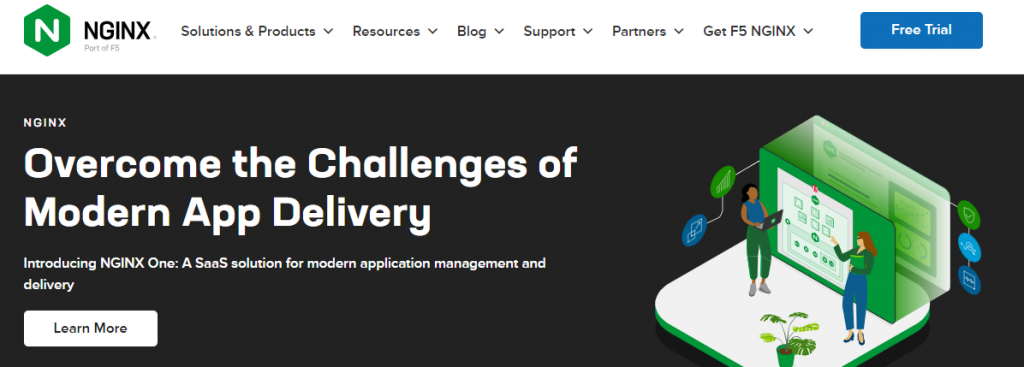Interested in learning about Load Balancer and their applications? Look no further!
Let’s understand load balancing through this simple example. Imagine you’re at a popular ice cream shop with only one cashier. There’s a long line of people waiting to order, and it’s getting crowded. Suddenly, the cashier can’t keep up with all the orders coming in, and some people end up waiting longer than others.
Now, imagine if the ice cream shop had multiple cashiers instead of just one. A “load balancer” would be like a smart manager who looks at the line of customers and sends each new customer to the cashier who is available and has the shortest line. This way, all the cashiers stay busy, and everyone gets their ice cream faster.
In simpler terms, a load balancer is like a traffic cop for computer servers. It helps spread out incoming requests from users across several servers so that no single server gets overwhelmed with too much work. This makes websites and online services run faster and more smoothly for everyone using them.
The below article is tailored just for you to explore all you need to know about Load Balancers. So grab your coffee and continue reading.
What is Load Balancing?

Load balancing is a technique used in computer networking to distribute incoming network traffic or computational tasks across multiple servers or resources. The primary goal of load balancing is to optimize resource utilization, prevent any single server from becoming overwhelmed, and ensure high availability, scalability, and reliability of the system. Essentially, it’s like a traffic manager that intelligently routes incoming requests to different servers to ensure that the workload is evenly distributed, leading to improved performance and responsiveness of applications and services.
Get exclusive access to all things tech-savvy, and be the first to receive
the latest updates directly in your inbox.
Load Balancing Technology
Load balancer technology encompasses various solutions for efficiently distributing network traffic across multiple servers. It includes algorithmic load balancing with techniques like round-robin and least connections. Hardware load balancers are dedicated physical appliances, while software load balancers run on server hardware or virtual environments. Cloud providers offer fully managed cloud load balancers. Advanced options like Application Delivery Controllers (ADCs) provide additional features such as content caching and SSL termination. Dynamic load balancing adjusts traffic distribution in real time, and global load balancing optimizes performance across distributed data centers or cloud regions. These technologies play a vital role in ensuring optimal performance, scalability, and reliability in modern IT infrastructure.
What is a Load Balancer Used for?
- Distributing incoming network traffic evenly across multiple servers
- Optimizing resource utilization to prevent server overload
- Ensuring high availability of applications and services
- Scaling infrastructure to handle varying workloads efficiently
- Improving performance and responsiveness of applications
- Reducing latency and improving user experience
- Providing fault tolerance by detecting and isolating faulty servers
- Enabling seamless deployment of updates and maintenance without downtime
Benefits of Load Balancing
Here are the key benefits of implementing load balancing:
- Improved Performance– Load balancing distributes incoming network or application traffic across multiple servers, preventing any single server from being overwhelmed. This optimizes resource usage and ensures faster response times for users, leading to improved overall performance of the system.
- Enhanced Scalability- Load balancers facilitate seamless scalability by dynamically allocating traffic to additional servers as demand increases. This allows organizations to easily handle spikes in traffic without experiencing degradation in performance or downtime, ensuring smooth operation even during peak periods.
- High Availability– Load balancing improves the availability of services by directing traffic away from servers that are experiencing issues or downtime. In the event of a server failure, the load balancer automatically redirects traffic to healthy servers, minimizing disruption and ensuring continuous access to applications and resources.
- Increased Reliability- With load balancing, organizations can achieve greater reliability and fault tolerance in their infrastructure. By distributing traffic across multiple servers, load balancers reduce the risk of single points of failure and ensure that services remain accessible even if individual servers experience issues or failures.
- Optimized Resource Utilization- Load balancers optimize resource utilization by evenly distributing traffic among servers based on predefined algorithms or rules. This prevents the overloading of individual servers and ensures that resources are used efficiently, leading to cost savings and improved operational efficiency.
Different Types of Load Balancer
Below are some of the most common types various types, each tailored to specific use cases and deployment scenarios:
Hardware Load Balancers
These are physical devices dedicated solely to load-balancing tasks. Hardware load balancers typically offer high performance and scalability and often include advanced features such as SSL termination and application layer filtering. They are suitable for large-scale deployments requiring high throughput and low latency.
Software Load Balancers
Software load balancers are deployed as software applications on standard server hardware or virtual machines. They offer flexibility and cost-effectiveness, as they can run on commodity hardware and be easily scaled as needed. Examples include NGINX, HAProxy, and Microsoft Application Request Routing (ARR).
Layer 4 (Transport Layer) Load Balancers
Layer 4 load balancers operate at the transport layer of the OSI model and make routing decisions based on IP addresses and TCP/UDP port numbers. They are capable of distributing traffic based on network-level information, such as round-robin or least connections. Layer 4 load balancers are well-suited for balancing TCP and UDP traffic but lack the ability to inspect application-layer data.
Layer 7 (Application Layer) Load Balancers
Layer 7 load balancers, also known as application delivery controllers (ADCs), operate at the application layer of the OSI model. They can make routing decisions based on application-specific data, such as HTTP headers, URLs, or cookies. Layer 7 load balancers offer advanced features like content-based routing, SSL offloading, and application-aware health checks, making them ideal for complex web applications and services.
Load Balancing Algorithms
Load balancing algorithms are the backbone of load balancers, determining how incoming requests are distributed across multiple servers to optimize performance, reliability, and resource utilization. Various algorithms exist, each with its own characteristics and suitability for different types of applications and environments. Here are some common load-balancing algorithms:
- Round Robin: Distributes requests evenly in a sequential manner.
- Least Connections: Routes requests to the server with the fewest active connections.
- IP Hash: Maps each client’s IP address to a specific server.
- Weighted Round Robin: Assigns weights to servers to adjust traffic distribution.
- Least Response Time: Directs requests to the server with the fastest response time.
- Randomized Load Balancing: Randomly selects a server for each request.
- Adaptive Load Balancing: Dynamically adjusts load distribution based on real-time monitoring.
Real-World Load Balancer Examples
Here are some real-world examples of load balancers:
NGINX

NGINX is a popular open-source web server and reverse proxy software that also functions as a load balancer. It is widely used to distribute incoming HTTP and HTTPS traffic across multiple backend servers. NGINX offers various load-balancing algorithms and can handle high volumes of traffic efficiently, making it a favorite among web developers and system administrators.

F5 BIG-IP

F5 BIG-IP is a leading hardware load balancer used in enterprise environments to manage and optimize application traffic. It offers a wide range of advanced features, including traffic shaping, SSL offloading, and application firewall capabilities. F5 BIG-IP is highly scalable and provides high-availability solutions for mission-critical applications and services.
Amazon Elastic Load Balancing (ELB)

Amazon ELB is a fully managed load-balancing service provided by Amazon Web Services (AWS). It automatically distributes incoming traffic across multiple EC2 instances or containers within an AWS region. Amazon ELB supports various load-balancing algorithms and integrates seamlessly with other AWS services, such as Auto Scaling and AWS Certificate Manager, to provide scalable and reliable application delivery in the cloud.
Cloud-based Load Balancing
Cloud-based load balancing leverages the scalability and flexibility of cloud computing to efficiently distribute incoming network traffic across multiple servers or resources. Services like Amazon Web Services (AWS) Elastic Load Balancing (ELB) and Microsoft Azure Load Balancer offer managed solutions that automatically handle the complexities of load balancing in cloud environments. These platforms dynamically scale resources based on demand, ensuring optimal performance and availability for applications and services. Cloud-based load balancing enables organizations to handle fluctuating workloads, improve fault tolerance, and deliver seamless user experiences across geographically dispersed regions.
FAQs
How do I choose the right load-balancing algorithm for my application?
The choice of load balancing algorithm depends on factors such as application requirements, traffic patterns, server capacity, and deployment environment. Common algorithms include Round Robin, Least Connections, IP Hash, Weighted Round Robin, Least Response Time, Randomized Load Balancing, and Adaptive Load Balancing.
Can load balancers handle SSL termination?
Yes, many load balancers support SSL termination, which offloads the SSL encryption and decryption tasks from the backend servers to the load balancer. This improves performance and reduces the computational burden on individual servers.
What is session persistence, and why is it important in load balancing?
Session persistence, also known as sticky sessions or session affinity, is a feature of load balancers that ensures that requests from the same client are consistently routed to the same backend server. This is important for maintaining user sessions and ensuring continuity of application state.
How do I monitor the performance of my load balancer?
Most load balancers provide built-in monitoring and reporting capabilities to track key performance metrics such as throughput, latency, server health, and traffic distribution. Additionally, third-party monitoring tools and integrations with monitoring platforms can be used to gain deeper insights into load balancer performance.
Can load balancers handle both incoming and outgoing traffic?
Yes, load balancers can handle both incoming and outgoing traffic. They can be configured to distribute incoming requests to backend servers and also perform outbound traffic shaping or routing based on predefined policies.
Conclusion
By efficiently distributing incoming traffic across multiple servers, load balancers improve response times, scalability, and fault tolerance, ultimately enhancing user experience and ensuring continuous availability of applications and services. As organizations continue to embrace digital transformation and cloud technologies, load balancers will remain essential components of resilient and high-performing IT infrastructures.



